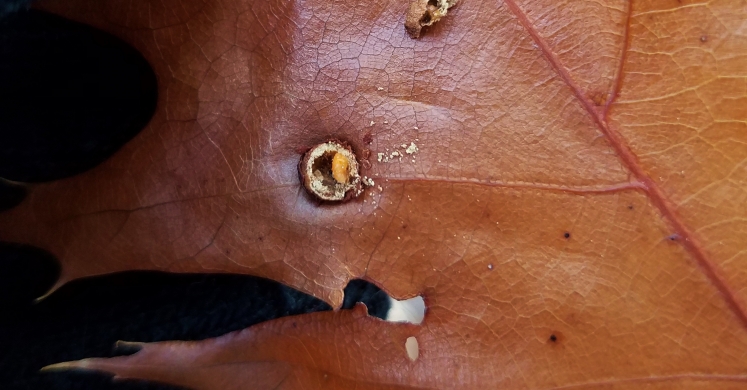Blog

#bioPGH Blog: Oak Galls
 A resource of Biophilia: Pittsburgh, #bioPGH is a weekly blog and social media series that aims to encourage both children and adults to reconnect with nature and enjoy what each of our distinctive seasons has to offer.
A resource of Biophilia: Pittsburgh, #bioPGH is a weekly blog and social media series that aims to encourage both children and adults to reconnect with nature and enjoy what each of our distinctive seasons has to offer.
Over this past weekend, the lovely fall weather called me outdoors for an afternoon at Boyce Park. While exploring the colors and sounds from the trails, I noticed that many of the red oak leaves in a particular area were sporting a number of little bumps (galls). Not completely sure what they were, I poked one of the bumps open to find a small, bright orange grub. One of the perks of working with an entomologist, Phipps’ Dr. Ryan Gott helped ID it as oak gall midge, Polystepha pilulae. Interesting little invertebrate, have you ever seen galls on leaves or trees? Let’s explore what’s happening with them!
By definition, a plant gall is any sort of abnormal growth (bumps, oddly shaped extensions) caused by an insect, mite, fungi, or even bacteria. In the case of insect-created leaf galls, the gall itself is formed by the plant when the invading insect’s saliva or the mechanical disruption of chewing signals the plant’s growth hormones to begin producing more tissue. This extra plant tissue forms a “tumor” of sorts in the area, which we recognize as a gall.
For gall-producing insects, like the oak gall midge that I found this week, a gall produces a relatively safe space for a developing larva. Adult midges lay their eggs on oak leaves, and the gall (once formed) offers larvae protection against the elements and the leaf provides a food source. This means that a gall is evidence of parasitism, but broadly speaking, leaf galls generally will not affect the health of the tree. They can be “unsightly” in ornamental home or garden settings, but unless the galls seem to have overwhelmingly taken over the leaves of the tree, it’s better to leave them alone rather than try to curb their growth (as a gardening bonus, some adult gall midges even prey on aphids!) Oaks win the unusual prize of being among the most popular tree for gall-forming bugs, as they can become host for over 500 different species of invertebrates. Granted, some galls can be very dangerous for trees, such as the crown gall, which is caused by bacteria. These galls, however, are large and obtrusive—quite beyond the small bumps I noticed on oak leaves.
It’s not just trees that can be the host of a gall; many plants can as well in some way or another. For example, earlier this fall, you might have noticed little round bumps on golden rod stems; these are caused by an insect called the goldenrod gall fly. Folks who grow azaleas in their home garden, particularly in the South, may have also noticed thickened, fleshy leaves on their bushes as a type of fungus creates galls on the leaf tissue.
Galls are interesting part of nature, and just a reminder of what makes it so…real! Not every little detail is picture-perfect—it’s real life. Bumps and all.
Connecting to the Outdoors Tip: If you’re investigating in exploring these little bumps, oak leaves in the area are a good bet for finding.
Continue the Conversation: Share your nature discoveries with our community by posting to Twitter and Instagram with hashtag #bioPGH, and R.S.V.P. to attend our next Biophilia: Pittsburgh meeting.
Resources
University of Missouri Extension: Galls on oak trees unsightly but harmless

